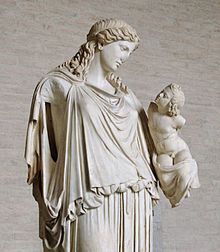Eirene (goddess)
| Eirene / Irene | |
|---|---|
Goddess of peace | |
| Member of The Horae | |
 Statue of Eirene with the infant Ploutos: Roman marble copy of bronze votive statue by Cephisodotus the Elder, now in the Glyptothek, Munich. | |
| Symbol | cornucopia, sceptre, torch, rhyton |
| Genealogy | |
| Parents | Zeus and Themis |
| Siblings | Eunomia, Dike, the Moirae, several paternal half-siblings |
| Equivalents | |
| Roman equivalent | Pax |
Eirene or Irene (/aɪˈriːniː/; Greek: Εἰρήνη, Ëirene, [eːrɛ́ːnɛː], lit. "Peace"),[1] more commonly known in English as Peace, is one of the Horae, the personification and goddess of peace in Greek mythology and ancient religion. She was depicted in art as a beautiful young woman carrying a cornucopia, sceptre, and a torch or rhyton. She is usually said to be the daughter of Zeus and Themis and thus sister of Dike and Eunomia. Her Roman equivalent is the goddess Pax.
Cult
[edit]Eirene was particularly well regarded by the citizens of Athens. After a naval victory over Sparta in 375 BC, the Athenians established a cult for Peace, erecting altars to her. They held an annual state sacrifice to her after 371 BC to commemorate the Common Peace of that year and set up a votive statue in her honour in the Agora of Athens. The statue was executed in bronze by Cephisodotus the Elder, likely the father or uncle[2] of the famous sculptor Praxiteles. It was acclaimed by the Athenians, who depicted it on vases and coins.[3]
Although the statue is now lost, it was copied in marble by the Romans; one of the best surviving copies is in the Munich Glyptothek. It depicts the goddess carrying a child with her left arm—Plutus, the god of plenty and son of Demeter, the goddess of agriculture. Peace's missing right hand once held a sceptre. She is shown gazing maternally at Plutus, who is looking back at her trustingly. The statue is an allegory for Plenty (i.e., Plutus) prospering under the protection of Peace; it constituted a public appeal to good sense.[3] The copy in the Glyptothek was originally in the collection of the Villa Albani in Rome but was looted and taken to France by Napoleon I. Following Napoleon's fall, the statue was bought by Ludwig I of Bavaria.[4]
References
[edit]- ^ Beekes, R. S. P. (2009). Etymological Dictionary of Greek. Brill. p. 391.
No etymology; Pre-Greek origin is very probable, principally because of the ending
- ^ Robertson, Martin (1981). A Shorter History of Greek Art. Cambridge University Press. p. 138.
[Praxiteles' father's name is not recorded,] but, given Greek practice of handing down names and crafts in the family, it is likely that if not Praxiteles' father, he was a relation.
- ^ a b Wünsche, Raimund (2007). Glyptothek, Munich: masterpieces of Greek and Roman sculpture. C. H. Beck. p. 79. ISBN 978-3-406-56508-3.
- ^ Robinson, Edward (1892). Catalogue of Casts Part III Greek and Roman Sculpture. Houghton, Mifflin & Co. p. 222.
External links
[edit] Media related to Eirene at Wikimedia Commons
Media related to Eirene at Wikimedia Commons
Ancient Greek deities | |||||||||||||
|---|---|---|---|---|---|---|---|---|---|---|---|---|---|
| Primordial deities | |||||||||||||
| Titans |
| ||||||||||||
| Olympian deities |
| ||||||||||||
| Water deities |
| ||||||||||||
| Chthonic deities |
| ||||||||||||
| Personifications |
| ||||||||||||
| Other deities |
| ||||||||||||
Text is available under the CC BY-SA 4.0 license; additional terms may apply.
Images, videos and audio are available under their respective licenses.
